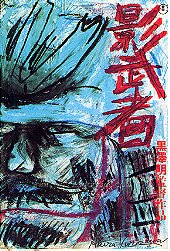If Kagemusha isn’t as daring as Akira Kurosawa’s other samurai epics, like Seven Samurai or Throne of Blood, then it is still a pleasurable jewel of a late master throwing around his considerable artistry and craft. The troubled birth and production doesn’t show (much), and it is an immensely pleasurable experience throughout. It simmers in its weightiness and epic scope, and Kurosawa still manages to pull it off with grace, beauty, and a deft touch that numerous imitators have tried and failed to achieve.
The title refers to a common thief who bears a striking resemblance to a warlord, and he effectively becomes his “shadow warrior,” what kagemusha translates to. This shadow warrior is something a spectral entity, more of an emotional cipher than a fully-realized character for the narrative to pivot around. We do not understand his motivations, nor are we lead to believe that he does either, but we follow him through his descent into a kind of madness and power-grab. Is he possessed by the warlord’s spirit or merely haunted by the warlord’s legacy?
This ambiguity becomes a driving force the latter portions of the film. In fact, a dream sequence can function under either reading of the material. These dream sequences in the third act of the film are the most audacious throughout the entire film as so much of it is a medium shot that takes in the vastness of the surroundings and the numerous players in the frame. They play with perspective and demonstrate our shadow warrior being terrorized and haunted by the warlord’s armor, or maybe he’s slowly being possessed. (Personally, I think he’s cracking up because his identity is being subsumed by the legacy and demands of his role, but plenty of professional critics have argued the other meaning.)
Yet there’s a pervasive irony to much of the middle portion of the film as the warlord’s death means that the thief must become the man, and only a handful of people know the truth. The “shadow warrior” begins to believe his own lie and slowly finds himself wanting to obtain power. The final masterstroke of this thread comes in the climactic battle, one of Kurosawa’s greatest sustained sequences of cinematic pageantry, where the thief dies chasing after the banner and unable to catch it. Not only was this thief never truly a warlord, but he was unable to maintain the illusion and cast out into the wilderness.
It’s a fairly simple plot and it’s only as good as any particular scene, some of which are transcendent and others reveal the break Kurosawa was forced to take between projects. At this point, despite being heralded by the New Hollywood class as a role model and iconoclast artist found funding hard to come by. Four years separated this film from his prior work, and the scenes where Kurosawa’s paintings are clearly adapted are the best. Others show a bit of aching joints, or like watching someone trying to get feeling back into a hand or foot that fell asleep.
None of this means that Kagemusha is a bad film, it is very much not but it is more of a second-shelf Kurosawa work and bettered by its predecessor, Ran. It perhaps colder than some of his greater works, but it’s still a great film. Kurosawa bookends the film with two sequences, one completely quiet that effectively explains the power dynamics at play and the other a bitterly ironic ending note. These two sequences alone are worth the viewing experience, but there’s so many other riches to discover along the way.
 Login
Login